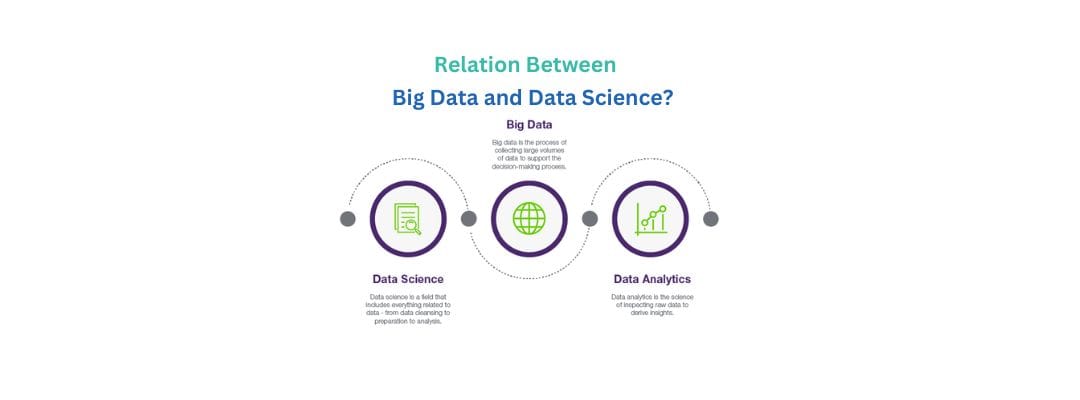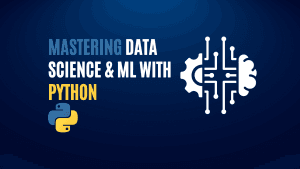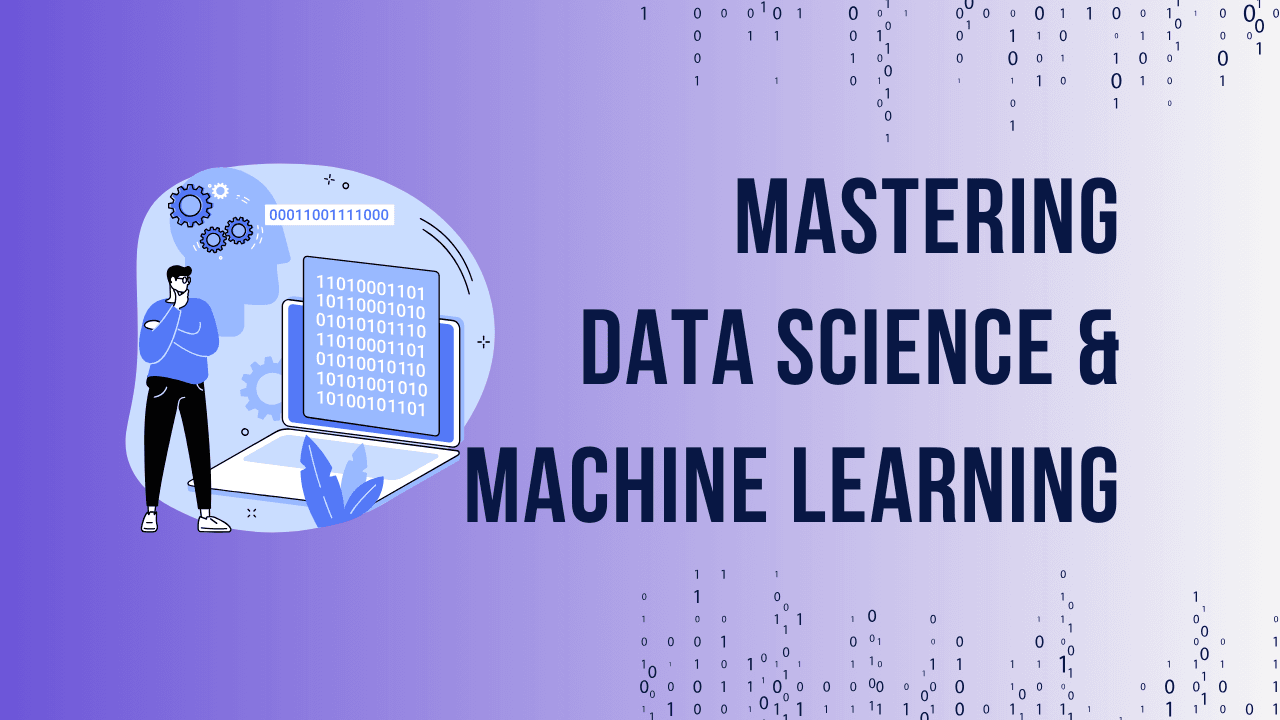Overview of Big Data and Data Science Big Data and Data Science are two of the most significant trends in the digital world today. While Big Data refers to vast volumes of data that are too complex to be processed by traditional data-processing software, Data Science is the field that leverages this data to extract meaningful insights. Understanding the relationship between Big Data and Data Science is crucial for businesses looking to harness the full potential of their data.
Importance of Understanding Their Relationship The convergence of Big Data and Data Science represents a transformative force in technology, providing organizations with the tools to analyze vast datasets, identify trends, and make data-driven decisions that can lead to improved outcomes.
Ready to take you Data Science and Machine Learning skills to the next level? Check out our comprehensive Mastering Data Science and ML with Python course.
Defining Big Data
Characteristics of Big Data (Volume, Variety, Velocity, Veracity, Value) Big Data is defined by its five key characteristics:
- Volume: The sheer amount of data generated.
- Variety: The different types of data (structured, unstructured).
- Velocity: The speed at which data is generated and processed.
- Veracity: The uncertainty and quality of data.
- Value: The potential value that can be derived from data.
Examples of Big Data Examples of Big Data include social media interactions, online transaction records, and sensor data from IoT devices.
Defining Data Science
Key Components of Data Science (Data Mining, Machine Learning, Statistical Analysis) Data Science encompasses a variety of techniques and tools aimed at analyzing and interpreting complex data. Key components include:
- Data Mining: The process of discovering patterns in large datasets.
- Machine Learning: A subset of artificial intelligence that enables systems to learn from data.
- Statistical Analysis: The application of statistical methods to understand data trends.
The Role of a Data Scientist Data Scientists play a critical role in translating Big Data into actionable insights, using their skills in programming, statistical analysis, and domain expertise.
Ready to take you Data Science and Machine Learning skills to the next level? Check out our comprehensive Mastering Data Science and ML with Python course.
The Intersection of Big Data and Data Science
How Big Data Drives Data Science Big Data provides the raw material that fuels Data Science. The vast amounts of data available today allow Data Scientists to create more accurate models, leading to better predictions and insights.
The Symbiotic Relationship Between Big Data and Data Science The relationship between Big Data and Data Science is symbiotic. Without Big Data, Data Science would lack the datasets necessary for in-depth analysis, while Big Data would remain unmanageable without the tools and techniques of Data Science.
Tools and Technologies in Big Data and Data Science
Common Tools (Hadoop, Spark, Python, R) Some of the most common tools used in both Big Data and Data Science include:
- Hadoop: A framework for distributed storage and processing of large datasets.
- Spark: An open-source analytics engine for big data processing.
- Python and R: Programming languages widely used in Data Science.
Integration of Big Data Tools in Data Science Processes The integration of tools like Hadoop and Spark into Data Science workflows allows for the efficient processing and analysis of large datasets.
Case Studies and Real-World Applications
Case Study 1: Big Data in Healthcare Big Data is revolutionizing healthcare by enabling predictive analytics and personalized medicine. For instance, analyzing patient data can lead to early diagnosis of diseases.
Case Study 2: Data Science in Finance In finance, Data Science is used to detect fraudulent activities, assess credit risks, and optimize investment strategies through data-driven insights.
Ready to take you Data Science and Machine Learning skills to the next level? Check out our comprehensive Mastering Data Science and ML with Python course.
Challenges in Big Data and Data Science
Data Quality and Integrity Issues Maintaining data quality and integrity is a significant challenge, as the accuracy of Data Science models heavily depends on the quality of the input data.
Scalability and Performance Challenges As data volumes grow, scalability and performance become critical issues, requiring robust infrastructure and optimized algorithms.
Future Trends in Big Data and Data Science
Emerging Technologies (AI, Edge Computing) Artificial Intelligence and Edge Computing are emerging technologies that will further enhance the capabilities of Big Data and Data Science.
Predictive Analytics and Future Data Science Trends Predictive analytics will continue to grow in importance, enabling organizations to anticipate trends and make proactive decisions.
Practical Applications
Implementing Big Data Solutions in Business Businesses can implement Big Data solutions to improve decision-making, customer experience, and operational efficiency.
Practical Tips for Data Scientists Working with Big Data Data Scientists should focus on continuous learning, collaboration with domain experts, and staying updated with the latest tools and technologies.
The Importance of Data Governance
Ensuring Compliance and Security Data governance involves ensuring that data handling practices comply with legal standards and security protocols.
Best Practices in Data Management Best practices in data management include maintaining data accuracy, implementing access controls, and regularly auditing data usage.
Conclusion
Summary of the Relationship Between Big Data and Data Science In summary, Big Data and Data Science are intrinsically linked, with Big Data providing the foundation for Data Science to generate insights and drive decision-making.
Final Thoughts and Call to Action As Big Data continues to grow, the importance of Data Science will only increase. Businesses should invest in both to stay competitive in the data-driven world.
Ready to take you Data Science and Machine Learning skills to the next level? Check out our comprehensive Mastering Data Science and ML with Python course.
Our Students Testimonials:
Frequently Asked Questions (FAQs)
1. What is the difference between Big Data and Data Science?
- Answer: Big Data refers to extremely large datasets that are complex and difficult to manage using traditional data processing tools. Data Science, on the other hand, involves using scientific methods, processes, algorithms, and systems to extract knowledge and insights from this data. Essentially, Big Data is the raw material, and Data Science is the process of analyzing and making sense of that material.
2. How does Big Data drive Data Science?
- Answer: Big Data provides the vast datasets necessary for Data Science to analyze and draw insights. The more data available, the more accurate and detailed the analysis can be. Big Data enables Data Scientists to develop predictive models, identify trends, and make data-driven decisions.
3. What tools are commonly used in Big Data and Data Science?
- Answer: Common tools include Hadoop and Spark for handling and processing large datasets, and Python and R for performing data analysis and creating models in Data Science. These tools help in managing the volume, velocity, and variety of Big Data while enabling sophisticated analysis in Data Science.
4. How do Machine Learning and Data Science relate to Big Data?
- Answer: Machine Learning, a key component of Data Science, uses algorithms to analyze and learn from Big Data. This learning process allows the creation of models that can make predictions or decisions based on new data. Machine Learning thus acts as a bridge between Big Data and Data Science.



